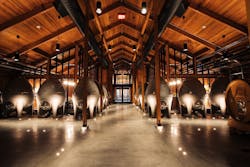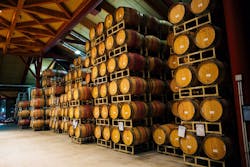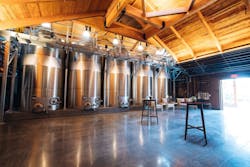Wine is a delicate product. Even the subtlest changes can mean the difference between serving a fine wine or a table wine. However, those subtleties start long before the cork pops. The distinctive quality of wine begins at the vineyard, where the winemaking process is an artform requiring precise timing, accuracy and cooling.
Cakebread Cellars is known for its award-winning wines produced at 18 vineyards from Napa Valley to Anderson Valley in northern California. While the region’s favorable weather and terrain produce exceptional grapes, it also presents challenges to the winemaking process. California's wildfires and subsequent power outages aimed at preventing more fires often produce instability in utility grids, which can put at risk the delicate balance of temperatures needed during the harvesting, crushing and fermenting processes.
“We age finished tanks at 50-60 °F, which is optimal because that's where the wine is most protected,” says Robert Wallace, winery facilities manager at Cakebread.
Temperatures during fermenting need to be regulated, so there's no damage to the yeast, which can cause unwanted problems. During aging, wine needs to be kept at a regulated temperature, so it doesn't get too cold and allow oxygen to permeate the wine. “Oxygen is not wine’s worst enemy, but it's not its best friend either,” Wallace adds.
So, maintaining a stable temperature during fermentation and aging is crucial because even slight fluctuations can change the wine's characteristics. Fluctuations in available power and regional weather patterns makes process reliability paramount at Cakebread Cellars’ glycol chiller facility. This is why an organic compound liquid that acts much like radiator fluid circulates through the tanks to extract heat and keep the wine in the 50-60 °F range. Reliability is particularly vital during the windy summer months, when harvest and production are at their peak. However, this is also when California's power grid stresses and frequent outages are most prevalent.
And Cakebread Cellars has certainly had its close calls. In the 2010s, the winery experienced three years of wildfire-induced interruptions to its processes. At the time, it didn’t have a reliable backup system. Luckily, outside temperatures were cool enough to enable using nitrogen to cool the tanks. After that experience, they knew it was time to come up with a reliable solution.
Cakebread understood the importance of having a trusted partner to help design a reliable process, and enlisted Novate Solutions Inc. in West Sacramento, Calif. Novate is a vertically integrated technology partner specializing in designing, implementing, and supporting industrial technology solutions.
“Our challenge from a controls perspective was to not only meet the thermodynamic needs of the plant and maintain fermentation precisely, but also to deal with a lack of stability in the grid,” says Carlos Rogers, president and CEO of Novate.
Pouring over control challenges
The winery’s chilled glycol plant needed a fully integrated solution with the flexibility to use power from multiple sources. Cakebread already generated some of its electricity using a gas turbine, but it wasn't enough to power the entire glycol chiller. Novate proposed incorporating multiple power feeds into the system, including backup generators, turbines and the utility grid. The plan also included a condenser to ensure continuous glycol flow, even during power outages, by connecting a generator to a 300-amp feed that kept the compressors and refrigeration yard operational. The two panels could draw power from different sources when needed to ensure a consistent supply.
California PUC Rule 21 regulates industrial customers generating their own electricity, meaning Novate’s approach to the glycol plant required collaboration with the plant team and the local utility. The plant needed to communicate with the generation system to predict when compressors or pumps should start or stop operations. California PUC Rule 21 prohibits exporting power back to the utility, so there’s a ceiling to how much energy could be generated onsite.
Novate selected a combination of ABB’s ACS580 variable frequency drives (VFD) and an ABB softstarter, each equipped with a fieldbus interface to provide real-time status with the generator and the plant’s control system. This arrangement ensured compliance with the rule and optimized operation of the chilled glycol plant.
Rogers reports the winery selected ABB’s units because they could integrate plant demands and collate close to real-time data collated in a unified environment. “ABB did a phenomenal job providing the construct that made this possible,” he says.
The ACS580 drives proved to be a reliable solution with an easy-to-use fieldbus interface that seamlessly integrated with Cakebread's existing control system. ACS580 is part of ABB's all-compatible drives portfolio with a consistent architecture and user interface. The ultra-low harmonic feature of ABB’s ACS drives play a crucial role in harmonic management, mitigating line noise, and preventing the need for costly, oversized backup generators.
In addition, Novate wanted to develop a hyper-flexible, chilled glycol system that lets Cakebread control its different aspects. “This is quite different than a typical package chiller we’d see in a food processing or semiconductor plant or other places,” Rogers says.
The glycol chiller plant needed separate, independent controls for each of the compressors, the cooling tower system and the pumping system because they not only pump chilled glycol but also condenser water. These requirements meant reducing compressor availability to reduce the electricity being drawn, and balancing it with the heat load.
“It’s a fine line. It requires sophisticated automation software to monitor the load on the pump, the actual current through the interfaces, and whether we have predominantly VFDs,” adds Rogers. “We also have some soft starters, so we're watching those, too. We're reducing the current introduced by equipment starts and stops. We're also reducing it to stay within the confines of our ability to generate on-premise. Or during certain periods, they bring in a backup diesel generator just as a spare."
Reducing downtime in the process
A single day of the chilled glycol plant being offline could result in a loss of an entire year's production. That’s because, when the ambient temperature gets too hot, the yeast starts to get out of control and can change the characteristics of the wine.
To build this hybrid system, Cakebread and Novate combined ABB technologies with software developed to adapt to all of the environmental characteristics of the plant. “So, when I just need the chiller, I turn it on. When I'm done chilling, I turn it off.,” Rogers explains. “But we actually throttle up and throttle down based on thermodynamic demands as well as electrical availability. We also calculate total energy used by the glycol-based chilled water system.”
The process also has two separate electrical feeds, so operators can understand what each is drawing and balance them.
Though the feeds are separate, they ultimately result in one loop, which becomes like two power generators on the same grid. They can reject more heat by running everything, and reject less heat by running less equipment and balancing it.
Cakebread operates two wineries, one located across a creek from the other. The glycol chiller plant is housed at the Rutherford Winery. The Oakville Winery is just a five-minute walk down a path. The system is set up in Rutherford, but it’s expected the same hybrid process will be set up at Oakville in the future.
Assurances and reliability
The new hybrid control process has yielded stellar results. Wallace estimates the chiller used to be down 50-60% of the time before instituting their new process. The days of having a refrigeration tech onsite almost every day and nursing the old system are long over, and he reports that Cakebread appreciates the reliability assurances of its new system.
The solution also involved integrating VFDs, soft starters and other equipment into a UL508A control panel that's cooled by the chilled-glycol system. Due to limited space, combining ABB's compact ACS580 drives and the water-cooled industrial control panel proved to be optimal for Cakebread's demanding operation.
Redundancy was the design philosophy for providing those assurances. The system is set up like a twin-engine airplane, so there’s still a way to fly if one engine goes down. The same concept applies to Cakebread’s new process for winemaking.
“It provides a mechanism that allows us in a pinch, even in the worst time like the middle of harvest, to isolate one system and service it while the other side continues to carry that thermodynamic load and prevent us from losing control of the process,” Rogers says.
About the Author

Leaders relevant to this article:



